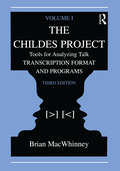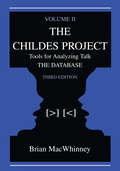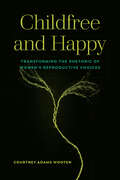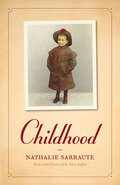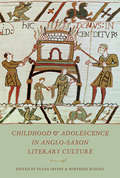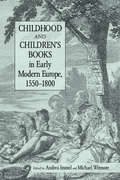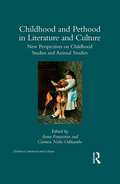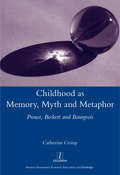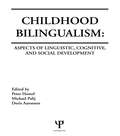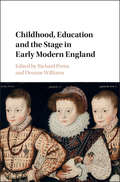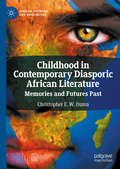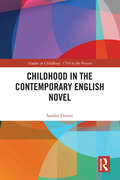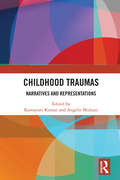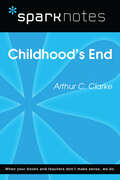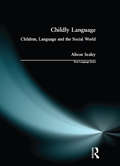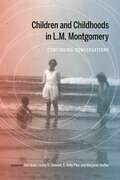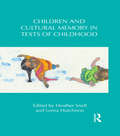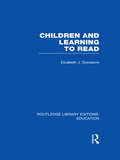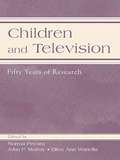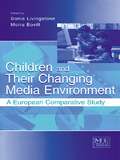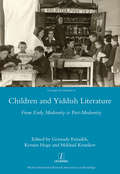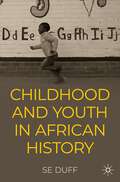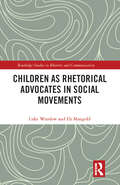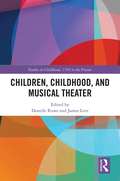- Table View
- List View
The Childes Project: Tools for Analyzing Talk, Volume I: Transcription format and Programs
by Brian MacWhinneyVolume I is the first of two volumes that document the three components of the CHILDES Project. It is divided into two parts which provide an introduction to the use of computational tools for studying language learning. The first part is the CHAT manual, which describes the conventions and principles of CHAT transcription and recommends specific methods for data collection and digitization. The second part is the CLAN manual, which describes the uses of the editor, sonic CHAT, and the various analytic commands. The book will be useful for both novice and experienced users of the CHILDES tools, as well as instructors and students working with transcripts of child language. Volume II describes in detail all of the corpora included in the CHILDES database. The conversational interactions in the corpora come from monolingual children and their caregivers and siblings, as well as bilingual children, older school-aged children, adult second-language learners, children with various types of language disabilities, and aphasic recovering from language loss. The database includes transcripts in 26 different languages. The CD-ROM that accompanies these volumes includes the transcript files described in Volume II. It runs on both Windows and Macintosh platforms. For more information or updates to the files, visit the CHILDES Web site at http://childes.psy.cmu.edu
The Childes Project: Tools for Analyzing Talk, Volume II: the Database
by Brian MacWhinneyVolume I is the first of two volumes that document the three components of the CHILDES Project. It is divided into two parts which provide an introduction to the use of computational tools for studying language learning. The first part is the CHAT manual, which describes the conventions and principles of CHAT transcription and recommends specific methods for data collection and digitization. The second part is the CLAN manual, which describes the uses of the editor, sonic CHAT, and the various analytic commands. The book will be useful for both novice and experienced users of the CHILDES tools, as well as instructors and students working with transcripts of child language. Volume II describes in detail all of the corpora included in the CHILDES database. The conversational interactions in the corpora come from monolingual children and their caregivers and siblings, as well as bilingual children, older school-aged children, adult second-language learners, children with various types of language disabilities, and aphasic recovering from language loss. The database includes transcripts in 26 different languages.
Childfree and Happy: Transforming the Rhetoric of Women's Reproductive Choices
by Courtney Adams WootenChildfree and Happy examines how millennia of reproductive beliefs (or doxa) have positioned women who choose not to have children as deviant or outside the norm. Considering affect and emotion alongside the lived experiences of women who have chosen not to have children, Courtney Adams Wooten offers a new theoretical lens to feminist rhetorical scholars’ examinations of reproductive rhetorics and how they circulate through women’s lives by paying attention not just to spoken or written beliefs but also to affectual circulations of reproductive doxa. Through interviews with thirty-four childfree women and analysis of childfree rhetorics circulating in historical and contemporary texts and events, this book demonstrates how childfree women individually and collectively try to speak back to common beliefs about their reproductive experiences, even as they struggle to make their identities legible in a sociocultural context that centers motherhood. Childfree and Happy theorizes how affect and rhetoric work together to circulate reproductive doxa by using Sara Ahmed’s theories of gendered happiness scripts to analyze what reproductive doxa is embedded in those scripts and how they influence rhetoric by, about, and around childfree women. Delving into how childfree women position their decision not to have children and the different types of interactions they have with others about this choice, including family members, friends, colleagues, and medical professionals, Childfree and Happy also explores how communities that make space for alternative happiness scripts form between childfree women and those who support them. It will be of interest to scholars in the fields of the rhetoric of motherhood/mothering, as well as feminist rhetorical studies.
Childhood
by Nathalie SarrauteAs one of the leading proponents of the "nouveau roman," Nathalie Sarraute is often remembered for her novels, including "The Golden Fruits," which earned her the Prix international de litterature in 1964. But her carefully crafted and evocative memoir "Childhood" may in fact be SarrauteOCOs most accessible and emotionally open work. Written when the author was eighty-three years old, but dealing with only the first twelve years of her life, "Childhood" is constructed as a dialogue between Sarraute and her memory. Sarraute gently interrogates her interlocutor in search of her own intentions, more precise accuracy, and indeed, the truth. Her relationships with her mother in Russia and her stepmother in Paris are especially heartbreaking: long-gone actions are prodded and poked at by Sarraute until they yield some semblance of fact, imbuing these maternalistic interactions with new, deeper meaning. Each vignette is bristling with detail and shows the power of memory through prose by turns funny, sad, and poetic. Capturing the ambience of Paris and Russia in the earliest part of the twentieth century, while never giving up the lyrical style of SarrauteOCOs novels, this book has much to offer both memoir enthusiasts and fiction lovers. "
Childhood and Adolescence in Anglo-Saxon Literary Culture (Toronto Anglo-Saxon Series)
by Susan Irvine Winfried RudolfChildhood and Adolescence in Anglo-Saxon Literary Culture counters the generally received wisdom that early medieval childhood and adolescence were an unremittingly bleak experience. The contributors analyse representations of children and their education in Old English, Old Norse and Anglo-Latin writings, including hagiography, heroic poetry, riddles, legal documents, philosophical prose and elegies. Within and across these linguistic and generic boundaries some key themes emerge: the habits and expectations of name-giving, expressions of childhood nostalgia, the role of uneducated parents, and the religious zeal and rebelliousness of youth. After decades of study dominated by adult gender studies, Childhood and Adolescence in Anglo-Saxon Literary Culture rebalances our understanding of family life in the Anglo-Saxon era by reconstructing the lives of medieval children and adolescents through their literary representation.
Childhood and Children's Books in Early Modern Europe, 1550-1800: Childhood And Children's Books In Early Modern Europe, 1550-1800 (Children's Literature and Culture #38)
by Andrea Immel Michael WitmoreFirst Published in 2006. Routledge is an imprint of Taylor & Francis, an informa company.
Childhood and Pethood in Literature and Culture: New Perspectives in Childhood Studies and Animal Studies (Children's Literature and Culture)
by Anna Feuerstein Carmen Nolte-OdhiamboBringing together new perspectives in childhood studies and animal studies, this book is the first collection to critically address the manifold alignments and frequent co-constitutions of children and pets in our families, our cultures, and our societies. The cultural politics of power shaping relationships between children, pets, and adults inform the wide range of essays included in this collection, as they explore issues such as protection, discipline, mastery, wildness, play, and domestication. The volume use the frequent social and cultural intersections between children and pets as an opportunity to analyze institutions that create pet and child subjectivity, from education and training to putting children and pets on display for entertainment purposes. Essays analyze legal discourses, visual culture, literature for children and adults, migration narratives, magazines for children, music, and language socialization to discuss how notions of nationalism, race, gender, heteronormativity, and speciesism shape cultural constructions of children and pets. Examining childhood and pethood in America, Europe, Asia, and the Pacific, this collection shows how discourses linking children and pets are pervasive and work across cultures. By presenting innovative approaches to the child and the pet, the book brings to light alternative paths toward understanding these figures, leading to new openings and questions about kinship, agency, and the power of care that so often shapes our relationships with children and animals. This will be an important volume for scholars of animal studies, childhood studies, children’s literature, cultural studies, political theory, education, art history, and sociology.
Childhood as Memory, Myth and Metaphor: Proust, Beckett, and Bourgeois
by Catherine Crimp"A fascination with childhood unites the artist Louise Bourgeois (1911-2010) and the writers Samuel Beckett (1906-89) and Marcel Proust (1871-1922). But while many commentators have traced their childhood images back to memories of lived experiences, there is more to their mythologies of childhood that waits to be explored. They invite us to move away from familiar ideas - whether psychological or biographical - about what a child can represent, and even what a child is. The haunting child figures of Bourgeois, Beckett and Proust echo each other as they show how imagining origins- for a life, for a work of art - involves paradoxes that test the limits of our forms of expression. Art meets literature, profusion meets concision, French meets English, and images of childhood reveal new insights in this encounter between three great figures of twentieth- and twenty-first-century culture. Catherine Crimp holds a PhD from the University of Cambridge and is currently Lectrice d'anglais at theEcole Normale Superieure de Lyon."
Childhood Bilingualism: Aspects of Linguistic, Cognitive, and Social Development
by Peter Homel Michael Palij Doris AaronsonFirst published in 1987. This volume is based primarily on a conference on childhood bilingualism held at New York University on June 25 and 26, 1982 with an interest in exploring the nature of bilingual cognition and the effect of bilingualism on psychological development.
Childhood, Education and the Stage in Early Modern England
by Richard Preiss Deanne WilliamsWhat did childhood mean in early modern England? To answer this question, this book examines two key contemporary institutions: the school and the stage. The rise of grammar schools and universities, and of the professional stage featuring boy actors, reflect the culture's massive investment in children. In this collection, an international group of well-respected scholars examines how the representation of children by major playwrights and poets reflected the period's educational and cultural values. This book contains chapters that range from Shakespeare and Ben Jonson to the contemporary plays of Tom Stoppard, and that explore childhood in relation to classical humanism, medicine, art, and psychology, revealing how early modern performance and educational practices produced attitudes to childhood that still resonate to this day.
Childhood in Contemporary Diasporic African Literature: Memories and Futures Past (African Histories and Modernities)
by Christopher E. OumaThis book examines the representation of figures, memories and images of childhood in selected contemporary diasporic African fiction by Adichie, Abani, Wainaina and Oyeyemi. The book argues that childhood is a key framework for thinking about contemporary African and African Diasporic identities. It argues that through the privileging of childhood memory, alternative conceptions of time emerge in this literature, and which allow African writers to re-imagine what family, ethnicity, nation means within the new spaces of diaspora that a majority of them occupy. The book therefore looks at the connections between childhood, space, time and memory, childhood gender and sexuality, childhoods in contexts of war, as well as migrant childhoods. These dimensions of childhood particularly relate to the return of the memory of Biafra, the figures of child soldiers, memories of growing up in Cold War Africa, queer boyhoods/sonhood as well as experiences of migration within Africa, North America and Europe.
Childhood in the Contemporary English Novel (Studies in Childhood, 1700 to the Present)
by Sandra DinterSince the 1980s novels about childhood for adults have been a booming genre within the contemporary British literary market. Childhood in the Contemporary English Novel offers the first comprehensive study of this literary trend. Assembling analyses of key works by Ian McEwan, Doris Lessing, P. D. James, Nick Hornby, Sarah Moss and Stephen Kelman and situating them in their cultural and political contexts, Sandra Dinter uncovers both the reasons for the current popularity of such fiction and the theoretical shift that distinguishes it from earlier literary epochs. The book’s central argument is that the contemporary English novel draws on the constructivist paradigm shift that revolutionised the academic study of childhood several decades ago. Contemporary works of fiction, Dinter argues, depart from the notion of childhood as a naturally given phase of life and examine the agents, interests and conflicts involved in its cultural production. Dinter also considers the limits of this new theoretical impetus, observing that authors and scholars alike, even when they claim to conceive of childhood as a construct, do not always give up on the idea of its ‘natural’ core. Accordingly, this book reconstructs how the English novel between the 1980s and the 2010s oscillates between an acknowledgment of constructivism and an endorsement of childhood as the last irrevocable quintessence of humanity. In doing so, it successfully extends the literary and cultural history of childhood to the immediate present.
Childhood Traumas: Narratives and Representations
by Kamayani Kumar; Angelie MultaniThis volume contributes to understanding childhoods in the twentieth and twenty-firstcentury by offering an in-depth overview of children and their engagement with the violent world around them. The chapters deal with different historical, spatial, and cultural contexts, yet converge on the question of how children relate to physiological and psychological violence. The twentieth century has been hailed as the "century of the child" but it has also witnessed an unprecedented escalation of cultural trauma experienced by children during the two World Wars, Holocaust, Partition of the Indian subcontinent, and Vietnam War. The essays in this volume focus on victimized childhood during instances of war, ethnic violence, migration under compulsion, rape, and provide insights into how a child negotiates with abstract notions of nation, ethnicity, belonging, identity, and religion. They use an array of literary and cinematic representations—fiction, paintings, films, and popular culture—to explore the long-term effect of violence and neglect on children. As such, they lend voice to children whose experiences of abuse have been multifaceted, ranging from genocide, conflict and xenophobia to sexual abuse, and also consider ways of healing. With contributions from across the world, this comprehensive book will be useful to scholars and researchers of cultural studies, literature, education, education policy, gender studies, child psychology, sociology, political studies, childhood studies, and those studying trauma, conflict, and resilience.
Childhood's End (SparkNotes Literature Guide Series)
by SparkNotesChildhood's End (SparkNotes Literature Guide) by Arthur Clarke Making the reading experience fun! Created by Harvard students for students everywhere, SparkNotes is a new breed of study guide: smarter, better, faster.Geared to what today's students need to know, SparkNotes provides:chapter-by-chapter analysis explanations of key themes, motifs, and symbols a review quiz and essay topicsLively and accessible, these guides are perfect for late-night studying and writing papers.
Childly Language: Children, language and the social world (Real Language Series)
by Alison SealeyChildly Language explores how attitudes and cultural assumptions about children and childhood are revealed in contemporary English. It addresses such questions as: How is concern for children's safety and welfare reflected in the vocabulary and grammar of contemporary English? and When we say that an adult is being 'childish', what are we saying about the characteristics of children?
Children and Childhoods in L.M. Montgomery: Continuing Conversations
by Rita Bode, Lesley D. Clement, E. Holly Pike and Margaret StefflerFrom Jane Austen to contemporary fanfiction and adaptations, literary portrayals of the child and imaginings of childhood are particularly telling indicators of cultural values and when they shift. Inspired by the responsive reading practices of L.M. Montgomery herself, those demonstrated by her characters, and those of her diverse readership, Children and Childhoods in L.M. Montgomery works with concepts of confluence, based on organic, non-linear readings of texts across time and space. Such readings reconsider views of childhood and children by challenging power hierarchies and inequities found in approaches that privilege more linear readings of literary influence. While acknowledging differences between childhood and adulthood, contributors emphasize kinship between child and adult as well as between past and present selves and use both scholarly approaches and creative reimagining to explore how the boundaries between different stages of life are blurred in Montgomery’s writing. Children and Childhoods in L.M. Montgomery addresses Montgomery’s challenges to prescribed assumptions about childhood while positioning her novels as essential texts in twenty-first-century literary, childhood, and youth studies. Contributors include Yoshiko Akamatsu (Notre Dame Seishin University), Balaka Basu (UNC Charlotte), Rita Bode (Trent University), Holly Cinnamon, Lesley D. Clement, Vappu Kannas, Heidi Lawrence (University of Glasgow), Kit Pearson, Rosalee Peppard Lockyer, E. Holly Pike, Laura Robinson (Acadia University), Kate Scarth (UPEI), Margaret Steffler (Trent University), William Thompson (MacEwan University), Bonnie Tulloch (UBC), Asa Warnqvist (Swedish Institute for Children’s Books)
Children and Cultural Memory in Texts of Childhood: Children And Cultural Memory In Texts Of Childhood (Children's Literature and Culture)
by Heather Snell Lorna HutchisonThe essays in this collection address the relationship between children and cultural memory in texts both for and about young people. The collection overall is concerned with how cultural memory is shaped, contested, forgotten, recovered, and (re)circulated, sometimes in opposition to dominant national narratives, and often for the benefit of young readers who are assumed not to possess any prior cultural memory. From the innovative development of school libraries in the 1920s to the role of utopianism in fixing cultural memory for teen readers, it provides a critical look into children and ideologies of childhood as they are represented in a broad spectrum of texts, including film, poetry, literature, and architecture from Canada, the United States, Japan, Germany, Britain, India, and Spain. These cultural forms collaborate to shape ideas and values, in turn contributing to dominant discourses about national and global citizenship. The essays included in the collection imply that childhood is an oft-imagined idealist construction based in large part on participation, identity, and perception; childhood is invisible and tangible, exciting and intriguing, and at times elusive even as cultural and literary artifacts recreate it. Children and Cultural Memory in Texts of Childhood is a valuable resource for scholars of children’s literature and culture, readers interested in childhood and ideology, and those working in the fields of diaspora and postcolonial studies.
Children and Learning to Read (Routledge Library Editions: Education)
by Elizabeth GoodacreThis is a study of the nature of the process whereby children go about the business of learning to read. The author relates her own practical teaching experience closely to studies in developmental psychology, and also considers the special needs of individual children. In all, the book provides an invaluable contribution to our understanding of the processes involved in learning to read, and it should be of interest not only to teachers, but also to parents of young children.
Children and Television: Fifty Years of Research (Routledge Communication Series)
by Norma Pecora John P. Murray Ellen Ann WartellaThis seminal volume is a comprehensive review of the literature on children's television, covering fifty years of academic research on children and television. The work includes studies of content, effects, and policy, and offers research conducted by social scientists and cultural studies scholars. The research questions represented here consider the content of programming, children's responses to television, regulation concerning children's television policies, issues of advertising, and concerns about sex and race stereotyping, often voicing concerns that children's entertainment be held to a higher standard. The volume also offers essays by scholars who have been seeking answers to some of the most critical questions addressed by this research. It represents the interdisciplinary nature of research on children and television, and draws on many academic traditions, including communication studies, psychology, sociology, education, economics, and medicine. The full bibliography is included on CD.Arguably the most comprehensive bibliography of research on children and television, this work illustrates the ongoing evolution of scholarship in this area, and establishes how it informs or changes public policy, as well as defining its role in shaping a future agenda. The volume will be a required resource for scholars, researchers, and policy makers concerned with issues of children and television, media policy, media literacy and education, and family studies.
Children and Their Changing Media Environment: A European Comparative Study (Routledge Communication Series)
by Sonia Livingstone Moira BovillFocusing on the meanings, uses, and impacts of new media in childhood, family life, peer culture, and the relation between home and school, this volume sets out to address many of the questions, fears, and hopes regarding the changing place of media in the lives of today's children and young people. The scholars contributing to this work argue that such questions--intellectual, empirical, and policy-related--can be productively addressed through cross-national research. Hence, this volume brings together researchers from 12 countries--Belgium, Denmark, Finland, France, Germany, the United Kingdom, Israel, Italy, the Netherlands, Spain, Sweden, and Switzerland--to present original and comprehensive findings regarding the diffusion and significance of new media and information technologies among children. Inspired by parallels and difference between the arrival of television in the family home during the 1950s and the present day arrival of new media, the research is based on in-depth interviews and a detailed comparative survey of 6- to 16-year-olds across Europe and in Israel. The result is a comprehensive, detailed, and fascinating account of how these technologies are rapidly becoming central to the daily lives of young people. As a resource for researchers and students in media and communication studies, leisure and cultural studies, social psychology, and related areas, this volume provides crucial insights into the role of media in the lives of children. The findings included herein will also be of interest to policymakers in broadcasting, technology, and education throughout the world.
Children and Yiddish Literature From Early Modernity to Post-Modernity: From Early Modernity To Post-modernity (Legenda Ser.)
by Gennady Estraikh Kerstin Hoge Krutikov MikhailChildren have occupied a prominent place in Yiddish literature since early modern times, but children’s literature as a genre has its beginnings in the early 20th century. Its emergence reflected the desire of Jewish intellectuals to introduce modern forms of education, and promote ideological agendas, both in Eastern Europe and in immigrant communities elsewhere. Before the Second World War, a number of publishing houses and periodicals in Europe and the Americas specialized in stories, novels and poems for various age groups. Prominent authors such as Yankev Glatshteyn, Der Nister, Joseph Opatoshu, Leyb Kvitko, made original contributions to the genre, while artists, such as Marc Chagall, El Lissitzky and Yisakhar Ber Rybak, also took an active part. In the Soviet Union, meanwhile, children’s literature provided an opportunity to escape strong ideological pressure. Yiddish children’s literature is still being produced today, both for secular and strongly Orthodox communities. This volume is a pioneering collective study not only of children’s literature but of the role played by children in literature.
Children and Youth in African History
by SE DuffThis textbook introduces readers to the academic scholarship on the history of childhood and youth in sub-Saharan Africa, with a particular focus on the colonial and postcolonial eras. In a series of seven chapters, it addresses key themes in the historical scholarship, arguing that age serves as a useful category for historical analysis in African history. Just as race, class, and gender can be used to understand how African societies have been structured over time, so too age is a powerful tool for thinking about how power, youth, and seniority intersect and change over time. This is, then, a work of synthesis rather than of new research based on primary sources. This book will therefore introduce mainstream scholars of the history of childhood and youth to the literature on Africa, and scholars of youth in Africa to debates within the wider field of the history of children and youth.
Children as Pawns: The Politics of Educational Reform
by Timothy A. HacsiHead Start. Bilingual education. Small class size. Social promotion. School funding. Virtually every school system in America has had to face these issues over the past thirty years. Advocates and dissenters have declared confidently that "the research" is on their side. But is it? In the first book to bring together the recent history of educational policy and politics with the research evidence, Timothy Hacsi presents the illuminating, often-forgotten stories of these five controversial topics. He sifts through the complicated evaluation research literature and compares the policies that have been adopted to the best evidence about what actually works. He lucidly explains what the major studies show, what they don't, and how they have been misunderstood and misrepresented. Hacsi shows how rarely educational policies are based on solid research evidence, and how programs that sound plausible simply do not satisfy the complex needs of real children.
Children as Rhetorical Advocates in Social Movements (Routledge Studies in Rhetoric and Communication)
by Luke Winslow Eli MangoldThis book examines “Rhetorical Children” as visible and vocal communicators, shaping public discourse on contentious social issues related to organized labor, civil rights, gun violence, and climate change. This book explores four key social movement case studies: the 1903 Mother Jones-led March of the Mill Children to reform child labor laws, the 1963 Dr. Martin Luther King, Jr.,-led Children’s Crusade to end segregation, the 2018 Parkland student-led March for Our Lives movement to end gun violence, and the ongoing struggle for climate change mitigation led by Swedish activist Greta Thunberg. Through these case studies, the book outlines three rhetorical strategies, namely children’s ability to activate adults’ moral obligation; to invoke threats to natality and lost childhood; and to disrupt social order. It enables readers to better understand rhetorical children and the rhetorical tools required for social movements. Assessing the powerful role children play in shaping public discourse, this book will be of interest to students and scholars in the fields of Communication Studies, Rhetoric, Public Address, Social Movements, and Cultural Studies.
Children, Childhood, and Musical Theater (Studies in Childhood, 1700 to the Present)
by James Leve Donelle RuweBringing together scholars from musicology, literature, childhood studies, and theater, this volume examines the ways in which children's musicals tap into adult nostalgia for childhood while appealing to the needs and consumer potential of the child. The contributors take up a wide range of musicals, including works inspired by the books of children's authors such as Roald Dahl, P.L. Travers, and Francis Hodgson Burnett; created by Rodgers and Hammerstein, Lionel Bart, and other leading lights of musical theater; or conceived for a cast made up entirely of children. The collection examines musicals that propagate or complicate normative attitudes regarding what childhood is or should be. It also considers the child performer in movie musicals as well as in professional and amateur stage musicals. This far-ranging collection highlights the special place that musical theater occupies in the imaginations and lives of children as well as adults. The collection comes at a time of increased importance of musical theater in the lives of children and young adults.
